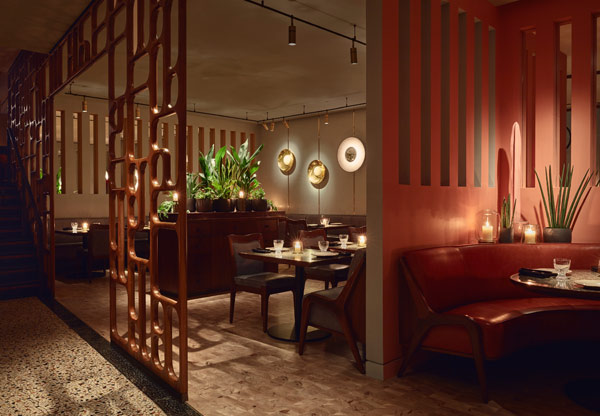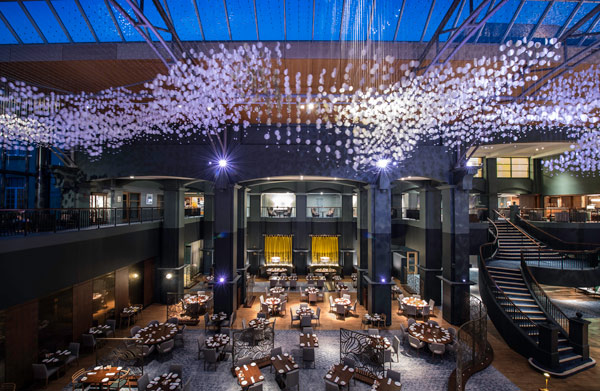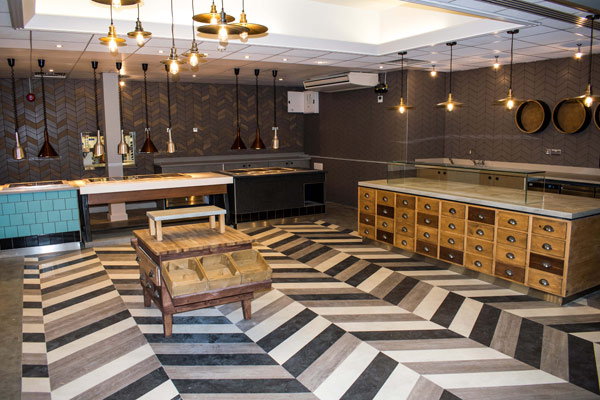The Caterer's 40 trends: design
As food trends evolve and travellers become ever more discerning, the design of hotels, restaurants and bars is becoming increasingly important. Here, we invite five designers to share their views on what is trending now
Dramatic wallscapes
Striking wall paintings will provide gorgeous backdrops, too, and Stein draws attention to trompe l'Å"il murals from Wall & Deco and to a "beautiful" large-scale panel wallpaper called Giardino Segreto, from Designers Guild, which features a landscape with flowers, greenery and the odd bird perched on a branch, as well as a vast lake and huge sky.
Colour trends will be bold, too. She expects to see more indigo, navy and midnight blue.
Stein, co-founder of the Rick Stein restaurant, rooms and shop empire, has created stylish and relaxed interiors across the businesses in Padstow, Porthleven, Fistral, Winchester, Sandbanks, Marlborough, Falmouth and Barnes.
Timeless craftsmanship and practicality David Collins Studio, famous for many landmark projects, including the Blue Bar at the Berkeley hotel and the Wolseley restaurant, both in London, and the Lime Wood hotel in the New Forest, takes an off-piste view of trends, as design director Lewis Taylor explains: "Our approach is to create timeless and unique spaces, and as a result we don't champion trends. Good design will transcend trends and stand the test of time. However, there are certain elements we always revisit when designing a space, such as craftmanship, colour, texture and detail - and a sense of place."
A case in point is the studio's recent project, Ella Canta, the restaurant headed by Mexican chef Martha Ortiz at London's InterContinental Park Lane hotel. "Our design concept centred around an almost 50-metre-long, hand-carved walnut screen, inspired by the work of Mexican furniture designer Eugenio Escudero," says Taylor. "It was not only a stunning focal point, but also worked on a practical level; creating individual areas to experience the space."
Versatile spaces for a bespoke experience
RPW Design also avoids seasonal whims in favour of a long-term design philosophy. "If we had to define our design protocol in three words it would be: experience, versatility and simplicity," says managing director Ariane Steinbeck.
"There is nothing more central in hospitality design than creating a space that evokes positive emotions and thus helps to create memorable experiences. Versatile spaces will give the hotel and its guests the ability to tailor-make their experiences, a strategy that stands the test of time. And finally, simplicity is what ensures we find the best solution for the first two points."
The Atrium at the Fairmont St Andrews is a good example of how these three rules can come together. The Atrium has a classic, clean aesthetic and sophisticated detailing and can be transformed from being a restaurant and relaxed lounge area to a function space depending on the hotel's needs. As a result, it can be personalised to suit guest requests. "It is the difference between a bespoke suit versus an off-the rack one," adds Steinbeck.
Food goes centre stage
When it comes to restaurants, Dexter Moren Associates director Neil Andrew argues that design trends are being driven by evolving food trends.
"More than ever diners want to know where their food or drink is produced and feel connected to the source," he says. "We are seeing a move from the visually theatrical to the sensory immersive, encouraging greater interaction with the food itself. Trends in eating range from providing sauce on the side, so diners can dress their own food, to sharing plates."
In response, designers are including larger tables for group sharing and bringing the kitchen into the dining space. Andrew singles out Nuno Mendes' Viajante in Bethnal Green, where diners find themselves almost sitting in the kitchen: "With counter-tops close to eye level, this provided a truly immersive experience: from farm to kitchen to table."
He also expects to see fewer wine walls and an increase in wine-tasting rooms that can double as private dining spaces. "Look at ways to communicate the quality and origin of produce; for example, using display larders and herb gardens," says Andrew.
Smarter lighting
For several years, warehouse-style lighting has been popular among dining spaces, but we are now moving out of that phase.
Michael Sinclair, design director at Catering Design Group, which has clients such as the Bonfire and Osteria restaurants at the Barbican Centre, London, the Wheatsheaf pub in Farnham, and Our Lady's Abingdon school, says: "The growing trend for vegan and more healthy eating options is being mirrored in lighting, with the use of fresher and more natural approaches. The overused look of standalone Edison bulbs and cage shades is giving way to stripped-back lighting amid clean-line interiors to reveal brighter, optimistic spaces."
Sinclair predicts there will be a more Californian feel to front of house spaces and a leaning towards Scandinavian boho-chic, where clear glass lights bounce off pale wood furniture. "The geometric trend seen in so many front of house designs is now being carried through to lighting," he adds. "Bold shapes will emerge and not only from the fittings themselves, but also through the light they cast. The popularity of gold, brass, silver, bronze and rose gold fittings continues to grow."
Many operators have embraced the LED bulb, which has a longer life and increases a site's eco credentials, but Sinclair says that LED lighting will get even smarter "with smart bulbs being controlled by phones, changing brightness and colour to reflect the changing day".
Continue reading
You need to be a premium member to view this. Subscribe from just 99p per week.
Already subscribed? Log In









